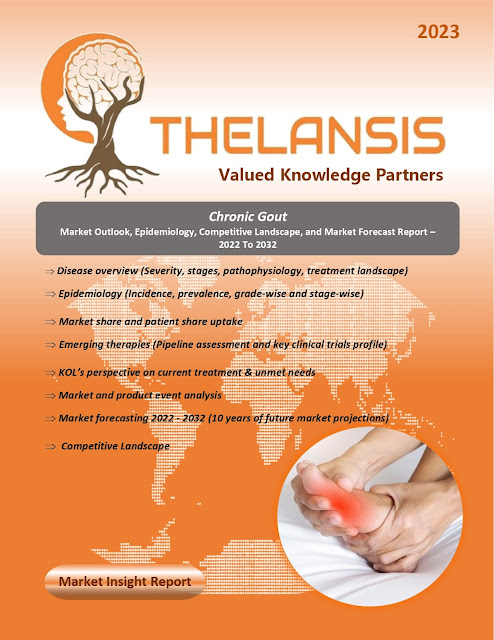Chronic Gout – Market Outlook, Epidemiology, Competitive Landscape, and Market Forecast Report – 2022 To 2032
Gout is a disorder of purine metabolism that causes hyperuricemia and generally refers to a form of arthritis. The first symptoms include intense pain in only one hallux joint in 90% of the cases. The elevated blood uric acid level in men (serum-urate level >7 mg/dl) and in women (serum-urate level >6) results in the formation of monosodium urate (MSU) crystals and deposition in joint bones and subcutaneous tissue. Hyperuricemia is not the only factor for gout. Other factors also implicated in gouts, such as age, gender, obesity, alcohol consumption, medication, comorbid disease, genetics, and purine diet. Hyperuricaemia and gout can be considered over four pathological stages development of hyperuricemia, deposition of monosodium urate crystals, the clinical presentation of gout flares due to an acute inflammatory response to deposited crystals, and clinical presentation of an advanced disease characterized by tophi.
·
The estimated prevalence of gout in U.S.
adults is 3.9% (5.2% in males and 2.7 in females).
Thelansis’s “Chronic Gout Market
Outlook, Epidemiology, Competitive Landscape, and Market Forecast Report – 2022
To 2032" covers disease overview, epidemiology, drug utilization,
prescription share analysis, competitive landscape, clinical practice,
regulatory landscape, patient share, market uptake, market forecast, and key
market insights under the potential Chronic Gout treatment modalities options
for eight major markets (USA, Germany, France, Italy, Spain, UK, Japan, and
China).
KOLs insights
of Chronic Gout across 8 MM market from the centre of Excellence/ Public/
Private hospitals participated in the study. Insights around current treatment
landscape, epidemiology, clinical characteristics, future treatment paradigm,
and Unmet needs.
Chronic Gout Market Forecast Patient
Based Forecast Model (MS. Excel Based Automated Dashboard), which Data Inputs
with sourcing, Market Event, and Product Event, Country specific Forecast
Model, Market uptake and patient share uptake, Attribute Analysis, Analog
Analysis, Disease burden, and pricing scenario, Summary, and Insights.
Thelansis Competitive Intelligence (CI) practice
has been established based on a deep understanding of the pharma/biotech
business environment to provide an optimized support system to all levels of
the decision-making process. It enables business leaders in forward-thinking
and proactive decision-making. Thelansis supports scientific and commercial
teams in seamless CI support by creating an AI/ ML-based technology-driven
platform that manages the data flow from primary and secondary sources.




Comments
Post a Comment